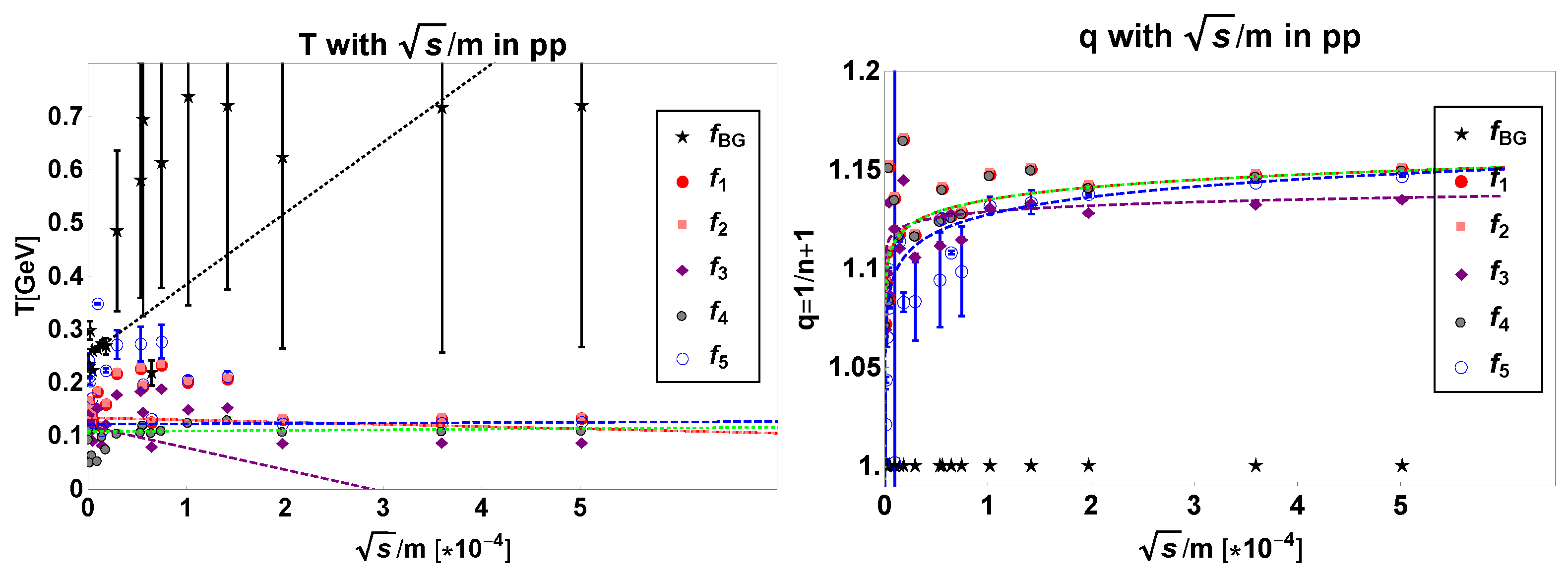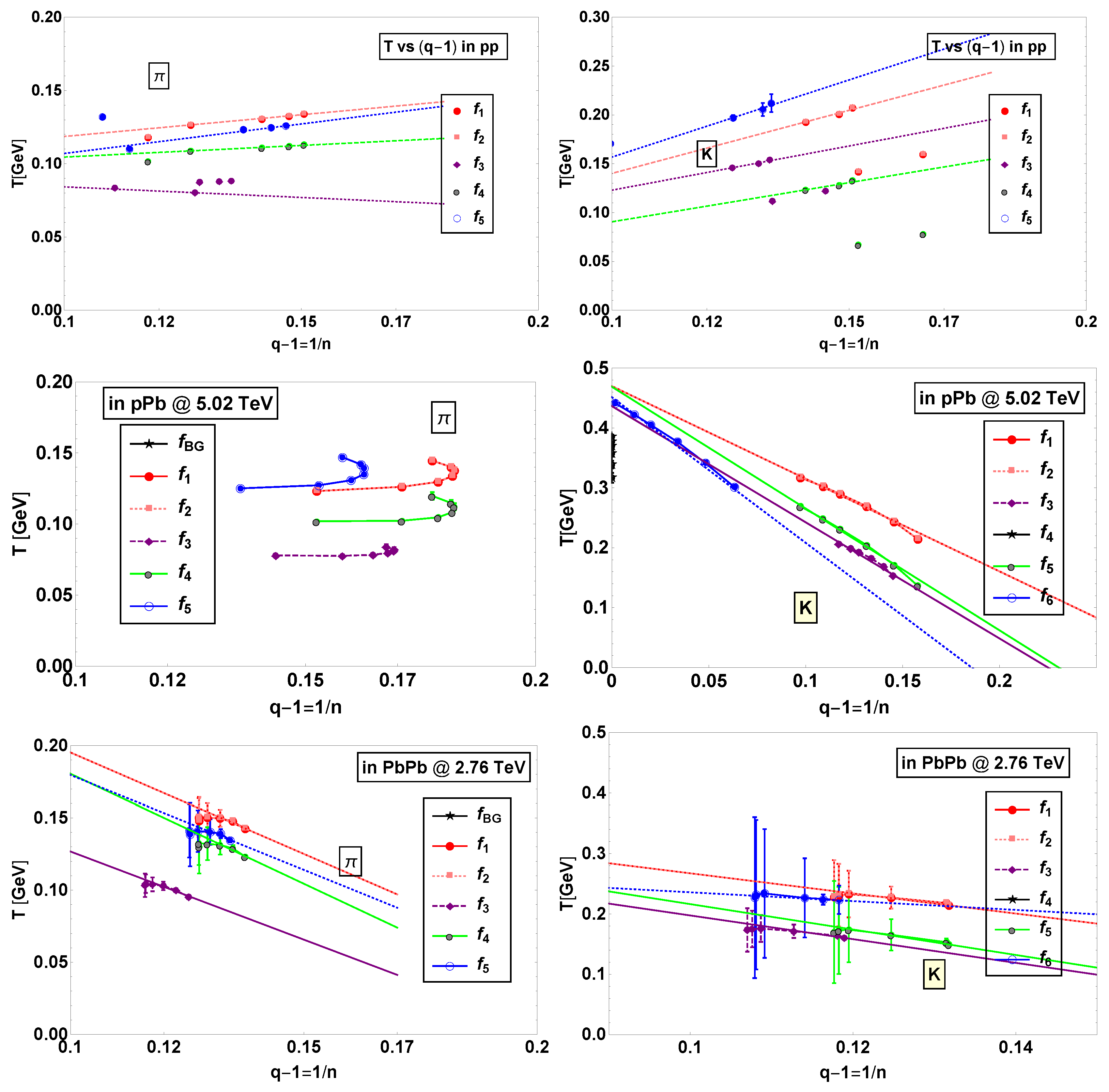Hadron Spectra Parameters within the Non-Extensive Approach †
Abstract
:1. Introduction
2. Results and Discussions
2.1. Analysis of the Spectra
2.2. Analysis of the and Results
3. Summary
Author Contributions
Funding
Acknowledgments
Conflicts of Interest
Abbreviations
| transverse momentum | |
| BG | Boltzmann–Gibbs |
| transverse mass |
References
- ALICE Collaboration. Enhanced production of multi-strange hadrons in high-multiplicity proton-proton collisions. Nat. Phys. 2017, 13, 535–539. [Google Scholar]
- ALICE Collaboration. ALICE measures pA collisions: Collectivity in small systems? J. Phys. Conf. Ser. 2017, 798, 012068. [Google Scholar]
- Pareto, V. Cours d’Economie Politique; Droz: Geneva, Switzerland, 1896. [Google Scholar]
- Hagedorn, R.; Multiplicities, T. pT distributions and the expected hadron → quark-gluon phase transition. Riv. Nuovo Cimento 1983, 6, 1–50. [Google Scholar] [CrossRef]
- Tsallis, C. Possible generalization of Boltzmann-Gibbs statistics. J. Stat. Phys. 1988, 52, 479–487. [Google Scholar] [CrossRef]
- Tsallis, C. Generalizing What We Learnt: Nonextensive Statistical Mechanics. In Introduction to Nonextensive Statistical Mechanics; Springer: New York, NY, USA, 2009; p. 382. [Google Scholar]
- Osada, T.; Wilk, G. Nonextensive hydrodynamics for relativistic heavy-ion collisions. Phys. Rev. C 2008, 77, 044903. [Google Scholar] [CrossRef]
- STAR Collaboration. Identified Baryon and Meson Distributions at Large Transverse Momenta from Au + Au Collisions at = 200 GeV. Phys. Rev. Lett. 2006, 97, 152301. [Google Scholar]
- BRAHMS Collaboration. Charged Meson Rapidity Distributions in Central Au + Au Collisions at = 200 GeV. Phys. Rev. Lett. 2005, 94, 162301. [Google Scholar]
- CMS Collaboration. Transverse momentum and pseudorapidity distributions of charged hadrons in pp collisions at sqrt(s) = 0.9 and 2.36 TeV. J. High Energy Phys. 2010, 2010, 41. [Google Scholar]
- CMS Collaboration. Transverse-Momentum and Pseudorapidity Distributions of Charged Hadrons in pp Collisions at = 7 TeV. Phys. Rev. Lett. 2010, 105, 022002. [Google Scholar]
- PHENIX Collaboration. Identified charged particle spectra and yields in Au + Au collisions at = 200 GeV. Phys. Rev. C 2004, 69, 034909. [Google Scholar]
- STAR Collaboration. Identified hadron spectra at large transverse momentum in p + p and d + Au collisions at = 200 GeV. Phys. Lett. B 2006, 637, 161–169. [Google Scholar]
- STAR Collaboration. K(892)* Resonance Production in Au + Au and p + p Collisions at = 200 GeV at RHIC. Phys. Rev. C 2005, 71, 064902. [Google Scholar]
- Wilk, G.; Wlodarczyk, Z. Interpretation of the Nonextensivity Parameter q in Some Applications of Tsallis Statistics and Lévy Distributions. Phys. Rev. Lett. 2000, 84, 2770–2773. [Google Scholar] [CrossRef] [PubMed]
- ALICE Collaboration. Production of pions, kaons and protons in pp collisions at = 900 GeV with ALICE at the LHC. Eur. Phys. J. C 2011, 71, 1655. [Google Scholar]
- ALICE Collaboration. Multiplicity Dependence of Pion, Kaon, Proton and Lambda Production in p + Pb Collisions at = 5.02 TeV. Phys. Lett. B 2014, 728, 25–38. [Google Scholar]
- PHENIX Collaboration. Identified charged hadron production in p + p collisions at = 200 and 62.4 GeV. Phys. Rev. C 2011, 83, 064903. [Google Scholar]
- ALICE Collaboration. Production of charged pions, kaons and protons at large transverse momentum in pp and Pb − Pb collisions at = 2.76 TeV. Phys. Lett. B 2014, 736, 196–207. [Google Scholar]
- Tang, Z.; Xu, Y.; Ruan, L.; van Buren, G.; Wang, F.; Xu, Z. Spectra and radial flow in relativistic heavy ion collisions with Tsallis statistics in a blast-wave description. Phys. Rev. C 2009, 79, 051901. [Google Scholar] [CrossRef] [Green Version]
- Shen, K.; Barnaföldi, G.G.; Biró, T.S. Hadronization within Non-Extensive Approach and the Evolution of the Parameters. arXiv 2019, arXiv:1905.05736. [Google Scholar]
- Shen, K.M.; Biro, T.S.; Wang, E.K. Different non-extensive models for heavy-ion collisions. Phys. A 2018, 492, 2353–2360. [Google Scholar] [CrossRef] [Green Version]
- Hagedorn, R. Hot and Hadronic Matter: Theory and Experiment; Plenum Press, Publishing House: New York, NY, USA, 1995; p. 13. [Google Scholar]
- Cleymans, J.; Lykasov, G.I.; Parvan, A.S.; Sorin, A.S.; Teryaev, O.V.; Worku, D. Systematic properties of the Tsallis distribution: Energy dependence of parameters in high energy p-p collisions. Phys. Lett. B 2013, 723, 351–354. [Google Scholar] [CrossRef]
- Barnaföldi, G.G.; Ürmössy, K.; Biró, T.S. Tsallis–Pareto–like Distributions in Hadron-Hadron Collisions. J. Phys. Conf. Ser. 2011, 270, 357–363. [Google Scholar] [CrossRef]
- Takacs, A.; Barnaföldi, G.G. Non-Extensive Motivated Parton Fragmentation Functions. Multidiscipl. Digit. Publ. Inst. Proc. 2019, 10, 12. [Google Scholar] [CrossRef]
- ALICE Collaboration. Centrality dependence of the nuclear modification factor of charged pions, kaons, and protons in Pb − Pb collisions at = 2.76 TeV. Phys. Rev. C 2016, 93, 034913. [Google Scholar]
- ALICE Collaboration. and Λ Production in Pb − Pb Collisions at = 2.76 TeV. Phys. Rev. Lett. 2013, 111, 222301. [Google Scholar]
- ALICE Collaboration. Multi-strange baryon production at mid-rapidity in Pb − Pb collisions at = 2.76 TeV. Phys. Lett. B 2014, 728, 216. [Google Scholar]
- ALICE Collaboration. K*(892)0 and ϕ(1020) production in Pb − Pb collisions at = 2.76 TeV. Phys. Rev. C 2015, 91, 024609. [Google Scholar]
- Wilk, G.; Włodarczyk, Z. On possible origins of power-law distributions. AIP Conf. Proc. 2015, 1558, 893–896, and its corresponding references. [Google Scholar]



| Collision Energy () | Produced Hadrons | ||||||
|---|---|---|---|---|---|---|---|
| 900 GeV | 110.8 | 0.2814 | 0.2814 | 0.4697 | 0.2814 | 1.456 | |
| K | 8.047 | 0.1748 | 0.1749 | 0.1698 | 0.1749 | 0.6669 | |
| p | 3.491 | 0.3724 | 0.3724 | 0.3735 | 0.3724 | 0.4145 | |
| 7 TeV | 1316.0 | 0.9681 | 0.9681 | 3.417 | 0.9681 | 0.3049 | |
| K | 520.2 | 0.4202 | 0.4202 | 0.4313 | 0.4202 | 3.100 | |
| p | 254.3 | 0.4481 | 0.4481 | 0.4356 | 0.4481 | 4.357 |
| [GeV] | K [GeV] | p [GeV] | |
|---|---|---|---|
| 62.4 GeV | 0.3–2.9 | 0.4–2 | 0.6–3.6 |
| 200 GeV | 0.3–3 | 0.4–2 | 0.5–4.6 |
| 900 GeV | 0.1–2.6 | 0.2–2.4 | 0.35–2.4 |
| 2.76 TeV | 0.1–20 | 0.2–20 | 0.3–20 |
| 5.02 TeV | 0.1–20 | 0.2–20 | 0.3–20 |
| 7 TeV | 0.1–20 | 0.2–20 | 0.3–20 |
| Fitting Functions | ||||
|---|---|---|---|---|
| 0.2515 ± 0.0005 | 0.1335 ± 0.0002 | - | - | |
| 0.1343 ± 0.0003 | −0.0041 ± 0.0001 | 1.135 ± 0.002 | 0.009 ± 0.001 | |
| 0.1343 ± 0.0003 | −0.0041 ± 0.0001 | 1.135 ± 0.002 | 0.009 ± 0.001 | |
| 0.1190 ± 0.0002 | −0.0412 ± 0.0002 | 1.129 ± 0.001 | 0.004 ± 0.001 | |
| 0.1083 ± 0.0003 | 0.0011 ± 0.0004 | 1.135 ± 0.002 | 0.009 ± 0.001 | |
| 0.1222 ± 0.0005 | 0.0007 ± 0.0001 | 1.127 ± 0.002 | 0.013 ± 0.002 |
| Particles | Mass [GeV] | [GeV] | [GeV] |
|---|---|---|---|
| 0.140 | 0.11–2.85 | 0.11–19 | |
| K | 0.494 | 0.225–2.45 | 0.225–19 |
| 0.498 | 0.05–7 | 0.45–11 | |
| 0.896 | 0.55–4.5 | ||
| p | 0.938 | 0.325–3.9 | 0.325–17.5 |
| 1.019 | 0.65–4.5 | ||
| 1.116 | 0.65–7 | 0.65–11 | |
| 1.321 | 0.7–7.5 | ||
| 1.672 | 1.3–7.5 |
| Particles | Fittings | in | in | in | in | in | in |
|---|---|---|---|---|---|---|---|
| −0.36 ± 0.02 | 0.08 ± 0.01 | - | - | 1.40 ± 0.02 | 0.335 ± 0.004 | ||
| −0.36 ± 0.02 | 0.08 ± 0.01 | - | - | 1.40 ± 0.02 | 0.335 ± 0.004 | ||
| −0.14 ± 0.04 | 0.07 ± 0.02 | - | - | 1.22 ± 0.02 | 0.249 ± 0.005 | ||
| −0.22 ± 0.01 | 0.08 ± 0.01 | - | - | 1.52 ± 0.02 | 0.333 ± 0.005 | ||
| −0.31 ± 0.03 | 0.08 ± 0.01 | - | - | 1.31 ± 0.01 | 0.311 ± 0.007 | ||
| −1.30 ± 0.02 | 0.011 ± 0.001 | 1.55 ± 0.02 | 0.470 ± 0.001 | 1.67 ± 0.06 | 0.434 ± 0.003 | ||
| −1.30 ± 0.02 | 0.011 ± 0.001 | 1.55 ± 0.02 | 0.470 ± 0.001 | 1.67 ± 0.06 | 0.434 ± 0.003 | ||
| K | −0.90 ± 0.04 | 0.032 ± 0.005 | 1.94 ± 0.03 | 0.436 ± 0.004 | 1.96 ± 0.03 | 0.394 ± 0.007 | |
| −0.81 ± 0.01 | 0.010 ± 0.004 | 2.03 ± 0.03 | 0.470 ± 0.003 | 2.11 ± 0.05 | 0.427 ± 0.006 | ||
| −1.59 ± 0.02 | −0.001 ± 0.0005 | 2.43 ± 0.01 | 0.453 ± 0.002 | 0.73 ± 0.02 | 0.309 ± 0.007 |
© 2019 by the authors. Licensee MDPI, Basel, Switzerland. This article is an open access article distributed under the terms and conditions of the Creative Commons Attribution (CC BY) license (http://creativecommons.org/licenses/by/4.0/).
Share and Cite
Shen, K.; Barnaföldi, G.G.; Biró, T.S. Hadron Spectra Parameters within the Non-Extensive Approach. Universe 2019, 5, 122. https://doi.org/10.3390/universe5050122
Shen K, Barnaföldi GG, Biró TS. Hadron Spectra Parameters within the Non-Extensive Approach. Universe. 2019; 5(5):122. https://doi.org/10.3390/universe5050122
Chicago/Turabian StyleShen, Keming, Gergely Gábor Barnaföldi, and Tamás Sándor Biró. 2019. "Hadron Spectra Parameters within the Non-Extensive Approach" Universe 5, no. 5: 122. https://doi.org/10.3390/universe5050122
APA StyleShen, K., Barnaföldi, G. G., & Biró, T. S. (2019). Hadron Spectra Parameters within the Non-Extensive Approach. Universe, 5(5), 122. https://doi.org/10.3390/universe5050122





